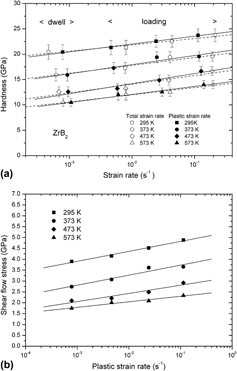Crossref Citations
This article has been cited by the following publications. This list is generated based on data provided by
Crossref.
Pettinà, M.
Biglari, F.
Jayaseelan, D. D.
Vandeperre, L. J.
Brown, P.
Heaton, A.
and
Nikbin, K.
2013.
Developments in Strategic Materials and Computational Design IV.
p.
283.
Wheeler, J.M.
Niederberger, C.
Tessarek, C.
Christiansen, S.
and
Michler, J.
2013.
Extraction of plasticity parameters of GaN with high temperature, in situ micro-compression.
International Journal of Plasticity,
Vol. 40,
Issue. ,
p.
140.
Wang, J.
and
Vandeperre, L. J.
2014.
Ultra‐High Temperature Ceramics.
p.
236.
Soler, Rafael
Wheeler, Jeffrey M.
Chang, Hyung-Jun
Segurado, Javier
Michler, Johann
Llorca, Javier
and
Molina-Aldareguia, Jon M.
2014.
Understanding size effects on the strength of single crystals through high-temperature micropillar compression.
Acta Materialia,
Vol. 81,
Issue. ,
p.
50.
Haghshenas, M.
Bhakhri, V.
Oviasuyi, R.
and
Klassen, R. J.
2015.
Effect of temperature and strain rate on the mechanisms of indentation deformation of magnesium.
MRS Communications,
Vol. 5,
Issue. 3,
p.
513.
Hamim, Salah U.
and
Singh, Raman P.
2017.
Taguchi-based design of experiments in training POD-RBF surrogate model for inverse material modelling using nanoindentation.
Inverse Problems in Science and Engineering,
Vol. 25,
Issue. 3,
p.
363.
Karthiselva, N. S.
Kashyap, Sanjay
Yadav, Devinder
Murty, B. S.
and
Bakshi, Srinivasa R.
2017.
Densification mechanisms during reactive spark plasma sintering of Titanium diboride and Zirconium diboride.
Philosophical Magazine,
Vol. 97,
Issue. 19,
p.
1588.
Islam, AZM Ariful
and
Klassen, Robert J.
2017.
Kinetics of length-scale dependent plastic deformation of gold microspheres.
Journal of Materials Research,
Vol. 32,
Issue. 18,
p.
3507.
Rohbeck, Nadia
Tsivoulas, Dimitrios
Shapiro, Ian P.
Xiao, Ping
Knol, Steven
Escleine, Jean-Michel
Perez, Marc
and
Liu, Bing
2017.
Comparison study of silicon carbide coatings produced at different deposition conditions with use of high temperature nanoindentation.
Journal of Materials Science,
Vol. 52,
Issue. 4,
p.
1868.
Korte-Kerzel, Sandra
2017.
Microcompression of brittle and anisotropic crystals: recent advances and current challenges in studying plasticity in hard materials.
MRS Communications,
Vol. 7,
Issue. 2,
p.
109.
Giuliani, Finn
Ciurea, Constantin
Bhakhri, Vineet
Werchota, Malcolm
Vandeperre, Luc J.
and
Mayrhofer, Paul H.
2019.
Deformation behaviour of TiN and Ti–Al–N coatings at 295 to 573 K.
Thin Solid Films,
Vol. 688,
Issue. ,
p.
137363.
Sim, Gi-Dong
Xie, Kelvin Y.
Hemker, Kevin J.
and
El-Awady, Jaafar A.
2019.
Effect of temperature on the transition in deformation modes in Mg single crystals.
Acta Materialia,
Vol. 178,
Issue. ,
p.
241.
Stanfield, Austin D.
Smith, Steven M.
Filipović, Suzana
Obradović, Nina
Buljak, Vladimir
Hilmas, Gregory E.
and
Fahrenholtz, William G.
2023.
Final‐stage densification kinetics of direct current–sintered ZrB2.
Journal of the American Ceramic Society,
Vol. 106,
Issue. 10,
p.
5654.
Shen, Sijia
Li, Hongbo
Wang, Chuanyun
Wu, Jinting
Zhao, Tingxing
and
Yang, Lingwei
2023.
Deformation mechanism and mechanical properties of TiN/ZrN nanolaminates by nanoindentation: effect of layer thickness and temperature.
Surface and Coatings Technology,
Vol. 455,
Issue. ,
p.
129230.
Feng, Xing
Sun, Guangpeng
Zhang, Sitong
and
Wen, Bin
2023.
A unified non-empirical strength model.
Frontiers in Materials,
Vol. 9,
Issue. ,
Mayrhofer, Paul H.
Clemens, Helmut
and
Fischer, Franz D.
2024.
Materials science-based guidelines to develop robust hard thin film materials.
Progress in Materials Science,
Vol. 146,
Issue. ,
p.
101323.
Deng, Qiyao
He, Pengfei
Sun, Chuan
Li, Yang
Xing, Yue
Wang, Yujie
Li, Jinglong
Liang, Xiubing
Wang, Xin
Zhou, Yujie
and
Cai, Yujun
2024.
High speed laser cladding as a new approach to prepare ultra-high temperature ceramic coatings.
Journal of Advanced Ceramics,
Vol. 13,
Issue. 2,
p.
143.
Honglin, Mou
Haichao, Zhao
Honggang, Tian
Guozheng, Ma
Ming, Liu
Haidou, Wang
Fengkuan, Xie
and
Zhihai, Cai
2024.
Effects of hBN content and particle size on microstructure, mechanical and tribological properties of NiCr-Cr3C2-hBN coatings.
Surface and Coatings Technology,
Vol. 478,
Issue. ,
p.
130330.
